
ASIA HUNDREDS is a series of interviews and conference presentations by professionals with whom the Japan Foundation Asia Center works through its many cultural projects.
By sharing the words of key figures in the arts and cultures in both English and Japanese and archiving the "present" moments of Asia, we hope to further generate cultural exchange within and among the regions.
George Town, a UNESCO World Heritage Site
Good afternoon. My name is Ang Ming Chee, and I am the General Manager of George Town World Heritage Incorporated. Today, I would like to introduce what we do at George Town and what efforts we undertake to safeguard its cultural heritage in an innovative way. One of the case studies that I bring you today is the George Town Heritage Celebrations, an annual event we host in commemorating George Town as a UNESCO World Heritage Site.*1
*1 The oldest quarters of George Town's city center was inscribed as a World Heritage Site by UNESCO on July 7, 2008. Officially, the heritage site is named "Melaka and George Town, Historic Cities of the Straits of Malacca."
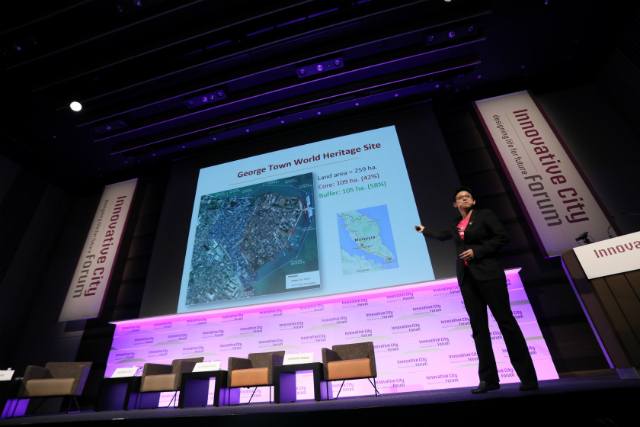
George Town is located at the northeastern tip on the island of Penang and the town itself is about 259 hectares in land area; about five times the size of Ueno Park in Tokyo. It is not very big, yet it's extremely unique. The safeguarding efforts that we pursue focus on three of UNESCO's criteria for Outstanding Universal Values which describe George Town and Melaka as below.
Criterion II: Melaka and George Town represent exceptional examples of multi-cultural trading towns in East and Southeast Asia, forged from the mercantile and exchanges of Malay, Chinese, and Indian cultures and three successive European colonial powers for almost 500 years, each with its imprints on the architecture and urban form, technology and monumental art. Both towns show different stages of development and the successive changes over a long span of time and are thus complementary.
Criterion III: Melaka and George Town are living testimony to the multi-cultural heritage and tradition of Asia, and European colonial influences. This multi-cultural tangible and intangible heritage is expressed in the great variety of religious buildings of different faiths, ethnic quarters, the many languages, worship and religious festivals, dances, costumes, art and music, food, and daily life.Criterion IV: Melaka and George Town reflect a mixture of influences which have created a unique architecture, culture and townscape without parallel anywhere in East and South Asia. In particular, they demonstrate an exceptional range of shophouses and townhouses. These buildings show many different types and stages of development of the building type, some originating in the Dutch or Portuguese periods.
Source: "Melaka and George Town, Historic Cities of the Straits of Malacca," UNESCO website.

Coexistence of Tangible and Intangible Cultural Heritage
My office, with the support from the State Government and its communities, is committed to conserve and safeguard both the tangible and intangible cultural heritages of George Town. We are guided by George Town's Special Area Plan *2 which outlines the conservation and management plan of the buildings and sites; the tangible heritages. Intangible cultural heritage, on the other hand, can be defined as socio-cultural practices, representations, expressions, knowledge, and skills that communities, groups, and individuals recognize as part of their cultural heritage. While safeguarding these intangible cultural heritage are, to be honest, rather challenging, our effort aims to ensure the continuity of cultural heritage from generation to generation and, at the same time, that it be recreated by the communities and groups. Without having any handbook to guide us, safeguarding these souls of George Town can, as I said, be very challenging.
*2 Under the provision of the Town and Country Planning Act 1976 (Act 172), the Special Area Plan [SAP] for the George Town World Heritage Site is issued by the State Authority, including detailed proposals, guidelines, and management strategies for implementation.
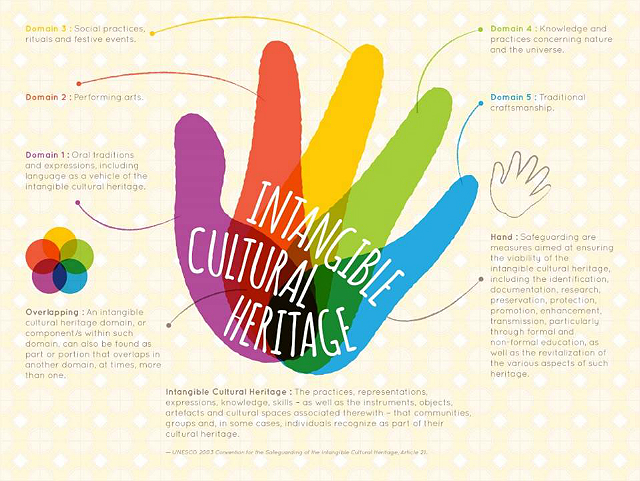 This is the postcard that we launched in 2015 to educate the public on intangible cultural heritage. Education and community empowerment are a few among our strategies, and we also conduct field surveys, research, and documentation, among other initiatives. Of all, my favorite is the George Town Heritage Celebrations as it is fun, feasible, interactive, and it involves the communities.
This is the postcard that we launched in 2015 to educate the public on intangible cultural heritage. Education and community empowerment are a few among our strategies, and we also conduct field surveys, research, and documentation, among other initiatives. Of all, my favorite is the George Town Heritage Celebrations as it is fun, feasible, interactive, and it involves the communities.
George Town Heritage Celebrations
George Town Heritage Celebrations was first launched in 2009 to celebrate George Town's inscription as a World Heritage Site. We also use it as a platform to discover our shared identities: what is George Town, and how do the communities who live and work there identify with the town? Each year, George Town Heritage Celebrations presents a theme in curating the programs and activities. We had "Colour, Culture, and Tradition" in 2013, "Living Legacies" in 2014, and "Eat Rite" in 2015. The theme for 2016 was on traditional sports and games, for which the slogan was "mai main!" I understand the Japanese translation is asobi ni kitene [let's play]. This year, the Heritage Celebration highlights eleven traditional sports and introduces twenty-three traditional games. We showcase many of our shared memories in a fun, interactive, and inclusive manner through introductory classes, forums, a street festival, workshops, demonstrations, and open court games. We design these with input from the communities each with very different ethnicities, social, religious, and linguistic backgrounds. These communities are the owners of the cultural heritage of George Town. However, a bridging mechanism is needed to translate their interpretations of cultural heritage into documented and interactive outcomes. We, at the George Town World Heritage Incorporated, precisely play that role.
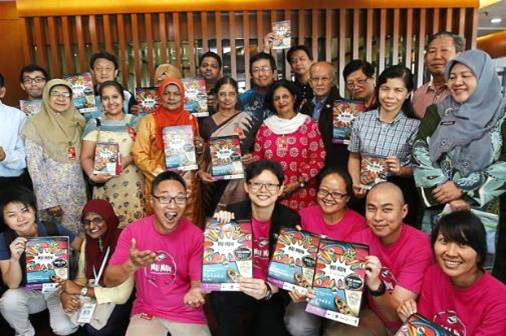 Here, I am wearing our pink colored T-shirt, especially made for this year's Celebration. It is not my most-favored color but our project curator said it can be the trend so I had to accept it. Thankfully—or obviously, maybe—all the volunteers loved it. And we colored George Town in pink throughout the three days of George Town Heritage Celebrations 2016.
Here, I am wearing our pink colored T-shirt, especially made for this year's Celebration. It is not my most-favored color but our project curator said it can be the trend so I had to accept it. Thankfully—or obviously, maybe—all the volunteers loved it. And we colored George Town in pink throughout the three days of George Town Heritage Celebrations 2016.
 All events need funds and we are very fortunate to have the full support from the State Government of Penang in supporting this. The annual budget for this year is about ten million Japanese Yen. We use it to pay for everything, including the salaries of our forty-three project staff who work hard throughout the hundred-and-twenty days of preparations, as well as all the expenses to host the event. We have a group of curators, designers, production crews, officers, promoters, and trainers for the volunteers. Almost all of them are excellent at engaging and socializing with the communities. We depend on such communication processes to identify and explore the cultural heritage such as the types of games the communities used to play when they were young. We also received help from the community associations in identifying the master and resource persons—another community empowerment effort that is crucial for our safeguarding efforts to be sustainable.
All events need funds and we are very fortunate to have the full support from the State Government of Penang in supporting this. The annual budget for this year is about ten million Japanese Yen. We use it to pay for everything, including the salaries of our forty-three project staff who work hard throughout the hundred-and-twenty days of preparations, as well as all the expenses to host the event. We have a group of curators, designers, production crews, officers, promoters, and trainers for the volunteers. Almost all of them are excellent at engaging and socializing with the communities. We depend on such communication processes to identify and explore the cultural heritage such as the types of games the communities used to play when they were young. We also received help from the community associations in identifying the master and resource persons—another community empowerment effort that is crucial for our safeguarding efforts to be sustainable.
Mai Main!: Reviving Traditional Sports and Games
As mentioned earlier, we have curated a total of twenty-three traditional-games workshops, six demonstrations of traditional sports, one forum, and four introductory classes, all throughout 7 to 9 July, 2016. We kick started the Celebration with the Official Opening Ceremony where senior officers from the State Government, including the Chief Minister himself, joined us to commemorate the occasion and to review our safeguarding efforts. We also use this occasion to acknowledge the contributions made by the community associations. Symbolic plaques are given to them and we also started a series of our media programming.
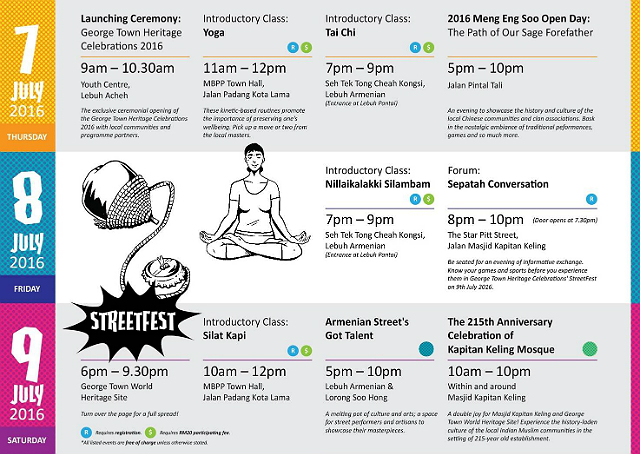 From the next day and during the Celebration, our staff members, the communities, and the volunteers facilitated the interactive platforms. Here is the program for the three days. We invited masters of Yoga, Tai Chi, Nillaikalakki Silambam, and Silat Kapi, and conducted introductory classes on them. Students were exposed to the basic movements of these activities in the three-hour intensive classes.
From the next day and during the Celebration, our staff members, the communities, and the volunteers facilitated the interactive platforms. Here is the program for the three days. We invited masters of Yoga, Tai Chi, Nillaikalakki Silambam, and Silat Kapi, and conducted introductory classes on them. Students were exposed to the basic movements of these activities in the three-hour intensive classes.
We also created twenty-three sets of game cards *3 on various traditional sports and games commonly played in George Town with the help of our community partners. These game cards are the results of the processes of community-engagements, oral documentations, and strategic programming. Most of these games are already very alien to the youngest generations in George Town, and so we tried really hard to organize our events in an innovative way which isn't necessarily high-tech; you can always be creative.
*3 These included the Gasing, Guli, Batu Tujuh, Pick-Up Sticks, Tudung Tin, Pallangguli, Chukkini, Congkak, Thayam, Animal Chess, Pin Ball, Uri Adithal, Sottangal, Skipping Rope, Pandu Atta,Sepak Raga, Baling Selipar, Toi, Nondi, Kola Kolaya Mundhirikai, Hopscotch, Handkerchief Game, Kali Toi.
 The game cards were distributed freely to more than seven thousand participants who joined us during the street events. A lot of them are families who live in George Town or nearby areas and some are commuters. Moreover, we have both young and older participants, so our programs and games are divided into low-energy games such as chess, and high-energy games where you can run around and sweat a lot.
The game cards were distributed freely to more than seven thousand participants who joined us during the street events. A lot of them are families who live in George Town or nearby areas and some are commuters. Moreover, we have both young and older participants, so our programs and games are divided into low-energy games such as chess, and high-energy games where you can run around and sweat a lot.
During the event, we transform George Town World Heritage Site into a car-free playground. The game stations are logistically located, and we have sponsorships from varying owners that open up their premises for free. I must mention that all of these activities are fully sponsored and we don't collect tickets. We want to encourage maximum participation. This year, we were fortunate to have a very beautiful day in good weather. Even it had rained, however, I would have said, "No plan B. We're going to do it. We're going to enjoy the unique landscape of George Town."
 One of the physical challenges we face when introducing these traditional games is that we no longer can purchase them on the market. So we had to think outside of the box and started making a new set with materials that we can get our hands on. One of the games we re-introduced during the Heritage Celebrations is "Animal Chess." It was a popular game during my childhood but it is not manufactured anymore. Our team had to reproduce the game pieces using recycled plastic-bottle caps and print our own game board. The game was well received by participants from all ages.
One of the physical challenges we face when introducing these traditional games is that we no longer can purchase them on the market. So we had to think outside of the box and started making a new set with materials that we can get our hands on. One of the games we re-introduced during the Heritage Celebrations is "Animal Chess." It was a popular game during my childhood but it is not manufactured anymore. Our team had to reproduce the game pieces using recycled plastic-bottle caps and print our own game board. The game was well received by participants from all ages.
 Another way that we try to encourage participation is through distributing the "Well-Done stickers." Participants who visited the game stations will be awarded a sticker as a token of their encouragement. It motivated the participants to complete all the games prepared during the Celebrations.
Another way that we try to encourage participation is through distributing the "Well-Done stickers." Participants who visited the game stations will be awarded a sticker as a token of their encouragement. It motivated the participants to complete all the games prepared during the Celebrations.
I must also mention that the Celebration doesn't end after its three-day period. We continue to utilize our resources and outputs. For example, the game cards have been translated into four languages—Tamil, Chinese, Malay, and English—and is available online for teachers, masters, and communities to download from the George Town World Heritage Incorporated website. We shared these materials with the public so that the communities can continue to introduce the games and sports to their members and visitors, teachers can use them as educational materials, and the masters can use for his/her students too.
We also try to make sure that the project team and volunteers do not go home with just the pink t-shirts. Through the continuous, interactive, and collective efforts with the community, we hope that these young people will remember the Heritage Celebrations with a better understanding of the commitments towards and from the community, the contents of the heritage, and better appreciate its importance. We hope that these generations will continue to safeguard our cultural heritage and be able to use the heritage in their own ways.
We encourage everyone to get involved in the pastime of yesteryears and, for some, to relive the nostalgic memories. By doing so, we hope that it will awaken our inner-selves in appreciating the simpler yet meaningful things that define and shape our identity. It is only through such continuity that the spirits of George Town will remain alive—it is a living museum after all.
I wish to end my presentation by inviting you to pencil-in July 7, 8 and 9, 2017 in your schedules for next year's George Town Heritage Celebration. We will continue to engage with the community and announce the new theme for the 2017 Heritage Celebration, *4 but all are welcome to join us in our efforts to safeguard the cultural heritage of George Town.
Thank you very much.
*4 As of January 2017, the theme for this year heritage celebrations will be focusing on the oral traditions and expressions, including the written and spoken languages of George Town.
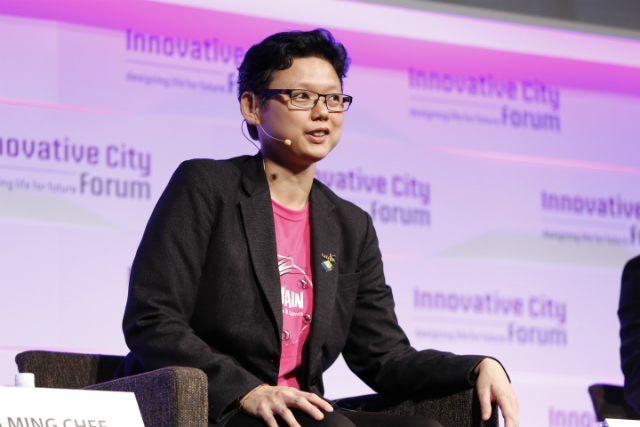
Plates: Courtesy of the Author







